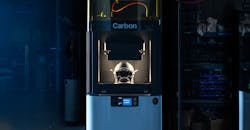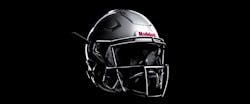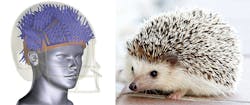Carbon Scores Big for 3D Printing with New Helmet
Tom Brady is 41 and playing in his 9th Super Bowl this Sunday, one year longer than the average football player's full career.
It's a brutal sport and medical researchers have only recently started to understand the lasting effects of violent hits to the head. One study found 99% of 111 NFL players studied had chronic traumatic encephalopathy (CTE). It really is amazing Brady has lasted this long, but a manufacturing process announced today by helmet-maker Riddell could keep many of the league's younger stars, including opposing quarterback Jared Goff, on the field much longer.
Using Carbon's Digital Light Synthesis method of 3D printing, Riddell engineers were able to create custom Diamond helmets, used in the 2018 season by select NFL players on several teams, with inserts comprised of 140,000 individual struts. The patterns were designed to attenuate the impact forces of crushing tackles while custom-made to comfortably fit on each individual.
Using Riddell's database of more than 5 million impacts, the equipment manufacturer will be able to create new lattices based on the needs of the specific player.
"As someone who’s spent thousands of hours watching film, I know that no two players play the same way," says Peyton Manning, Brady's retired AFC nemesis and Riddell strategic advisor.
"They all have different styles and tendencies on the field, which is another key benefit to Riddell’s Diamond technology. With the SpeedFlex Precision Diamond, players are not only experiencing the latest in head protection, but they can also dictate where the helmet is positioned to improve sightlines and maximize field vision."
The total solution was announced today, using Carbon's new L1 DLS printer, a proprietary highly damping elastomer, and software called Carbon Lattice Engine that employs simulations and design optimization to control the linear and rotational impact energies.
"Our platform enables companies like Riddell to make products that were never thought possible," said CEO and Co-Founder Joseph DeSimone. "With this partnership, Riddell becomes one of the largest users of 3D printers in the world."
The helmets will be commercially available later this year. The breakthrough will certainly ease the minds of parents worried about their kids playing football—as concussion fears have contributed to a 6.6% drop in high school players over the last decade, according to the National Federation of State High School Associations.
But there's a bigger story hidden here. These exotic lattices, which now can be produced at larger scales, represent the future of manufacturing design. What is now used as an insert to protect elite athletes from crashes in a decade's time may work their way into the door panels of your family sedan.
A few years ago, a biomimicry-based company called Hedgemon developed a 3D-printed structure based on hedgehog quills to pad the interiors of football helmets. The Northeast Ohio startup theorizes the same pattern could be used to make automobiles safer.
Given the resources of automotive OEMs, advances in generative design, and topology optimization, combined with actual solutions such as the Carbon L1, this announcement doesn't just represent a big win for football players, but possibly for all of us.
We're not really sure how this tech will expand, only that it will. And on behalf of all Cleveland Browns fans, is it too much to ask that Baker Mayfield get one of these helmets tomorrow?
About the Author
John Hitch
Editor, Fleet Maintenance
John Hitch, based out of Cleveland, Ohio, is the editor of Fleet Maintenance, a B2B magazine that addresses the service needs for all commercial vehicle makes and models (Classes 1-8), ranging from shop management strategies to the latest tools to enhance uptime.
He previously wrote about equipment and fleet operations and management for FleetOwner, and prior to that, manufacturing and advanced technology for IndustryWeek and New Equipment Digest. He is an award-winning journalist and former sonar technician aboard a nuclear-powered submarine where he served honorably aboard the fast-attack submarine USS Oklahoma City (SSN-723).



